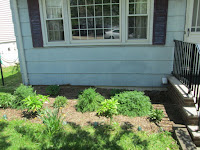Yesterday we were busy dancing in the May (actually in person this year, though we had to adapt some of our dances for social distancing), but today we celebrated the spring Gardeners' Holiday at home by planting all our garden seedlings. These weren't actually scheduled to go in the ground until next weekend, but the weather has been so balmy, and the seedlings (with one exception you'll hear about later) looked so big and healthy, that we decided to jump the gun and plant them now. And, since we were doing that, we just went ahead and got the crops we're starting from seed off to an early start as well.
Here you see our array of seedlings: tomatoes, peppers, and marigolds. We did not actually plant all of these; Brian habitually starts at least twice as many seedlings as we expect to need to ensure that we have enough healthy ones to put in the ground. And to make assurance double sure, he generally puts two or three seeds into each seedling tube, then thins out the extras when they come up. And as you can see, with most of the seeds we started this year, this plan worked almost too well, leaving us with an embarrassment of riches, particularly in the tomato department. We planted two each of Opalka, Premio, Pineapple, and Sun Gold, and we have two of each left over. (The extras usually go to his coworkers, but since he's still working from home, this year we're planning to give them away to members of the local gardening group.)However, there was one new variety that, even with all Brian's extra-careful efforts, still was not ready for planting. That's our new Apple pepper, an allegedly "depen
And our work didn't stop in the garden proper. We also added one new echinacea plant to our flowerbed in the front yard. As you can see, the plants have all grown quite a bit since we put them in last year. However, they suffered some deer damage early on, before we added our new invisible fence to keep the deer out. Nearly all the plants got munched on to some extent, and while most of them eventually recovered, one of the coneflowers did not. So along with the rest of this year's seedlings, Brian sprouted a new one to replace it. It's now installed in the back corner of the flowerbed, temporarily covered by a chicken-wire cage to protect it until it gets a bit bigger. (We also need to replace most of the violas, but those will go in later.)After we finished planting, we filled the watering can several times from our rain barrel to give all the plants, new and old, a good soaking. And, while we were at it, we added some water to a few other newcomers in our garden. The first is a new honeyberry bush, which we purchased this year after realizing that one of our five existing bushes hadn't survived the winter. Most of the plants had begun forming new leaves, but this one, one of the two Tana plants, showed no signs of budding at all. In fact, we debated buying two new bushes, because we weren't entirely sure whether the other Tana bush was still alive either, but after examining it carefully, we thought it was just a little later budding than the others. So we bought just one new plant. We considered trying a new variety, since the Tanas had not performed so well, but we decided to take our chances on another Tana, since it was available as a two-year-old plant and the other variety came only in a smaller size that we feared would not be mature enough to pollinate our two Keiko plants. Here is the new one, already larger and healthier than the one it replaced — and, as you can see, it has indeed blossomed, so we hope it and the Keikos may all produce berries this year. (As it turns out, we really should have bought two, since the other Tana turned out to be dead after all. But oh well, we can always replace it next year.)
And we also have several new asparagus plants in both the backyard and side-yard beds. We could see that there were some spaces in the beds where no plants were growing, and we had planned to go back to the Belle Mead Co-Op and buy some new asparagus crowns to fill in the gaps. However, on a recent trip to Ocean State Job Lot, a big discount store where we like to shop mainly for interesting foodstuffs, we found a big section in the front devoted to garden supplies. To our surprise, among the seeds and trowels were packages of asparagus crowns, containing six crowns each for just four bucks. The label didn't say what variety they were, but we figured at that price, we didn't have much to lose by giving them a try. In fact, it turned out to be an even better deal than we thought, since the package actually contained seven crowns, not six. Brian managed to squeeze the extra in by digging a second row in the side-yard bed so the plants could go in one behind the other. The indentations you see here in the backyard bed are the spaces where the new plants were added.
So, in short, there are quite a lot of new plants in the yard at the moment. If all of them are successful, we can look forward to a summer filled with beans and greens, squash and cucumbers, crisp peppers, ripe tomatoes, and sweet, juicy honeyberries. And for now, there's the satisfaction of looking out at the garden and seeing it green and growing and full of promise thanks to our efforts. Something attempted, something done, has earned an evening of relaxing on the couch watching Critical Role before bed.









No comments:
Post a Comment